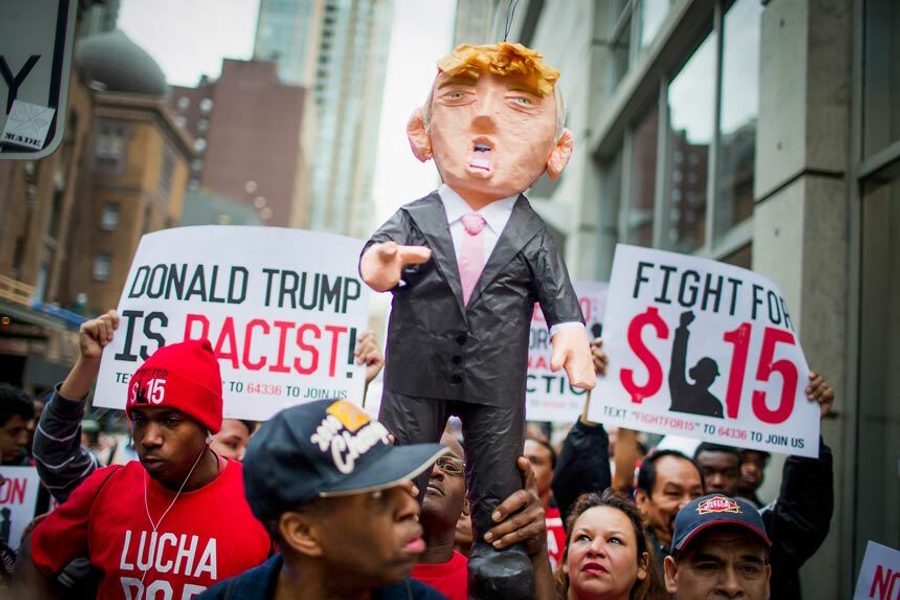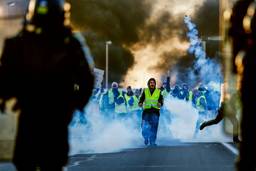
Salvador Seda has voted for the Democrat in every presidential election since he first registered in 1963. More than half a century later, the retiree and resident of Cleveland’s working-class Puritas-Longmead neighborhood is ending his streak.
“I’m going to vote for Donald Trump,” Seda told a canvasser from Showing Up for Racial Justice Action (SURJ Action) who had knocked on his door. “He might not know much about politics, but he’s a businessman. … In Washington, they have politicians that have been senators for 40 and 50 years. It’s time that these people get out and let some young blood in.”
Leaving Seda’s house, canvasser Caroline Meister acknowledged the visit hadn’t gone as planned. The recent college graduate volunteered a few hours on a sleepy Saturday afternoon in May to fight Trump through a technique that SURJ Action, a group that organizes white people for racial justice, calls “deep canvassing.” SURJ Action organizers aim to move potential voters leftward by listening to their concerns and helping them identify the source of their woes. In this low-income section of Cleveland, serenaded by the perpetual hum of planes from the nearby airport, SURJ Action encouraged canvassers to focus on economic insecurity. Even so, Meister struggled.
She led with a question about the $15 minimum wage — a popular proposal that Trump opposes — but the retiree pushed back, saying it would hurt business owners. And while Seda is Puerto Rican and his wife Mexican, he rejected Meister’s overtures about discrimination and railed against undocumented immigration.
The exchange illustrates the challenge of defeating Trump and undercutting the deeper roots of his right-wing populism: America is angry and Trump has a remarkable gift for channeling that anger. In his diagnosis of the country’s woes, the presumptive Republican nominee is blunt and unapologetically racist: It’s the fault of undocumented immigrants for bringing crime and of Muslims for making us unsafe. Walls and travel bans may be tough, the logic goes, but they’re necessary.
This rhetoric scares many Americans. “A Trump presidency represents an existential threat to immigrants in America,” says Lynn Tramonte, deputy director of America’s Voice, a D.C.- based immigrant advocacy group. “His immigration policies are entirely based on expulsion, exclusion and building a fortress around America.”
“Trump says he’ll deport all undocumented immigrants within the first two years of his presidency. Take a moment to imagine how that gets carried out: agents showing up at homes, carting away mothers and fathers. Raids on farms and factories. … Imagine what it would feel like, as Americans, to see this happening. That’s why we all need to rise up and defeat him.”
Doing so is made more difficult, however, by a near-certain Democratic nominee who some worry lacks the background and vision to undercut Trump’s anti-establishment appeal. If Hillary Clinton cannot muster a message that speaks to alienated, downand-out sections of white America, then it could fall on the backs of those working outside her campaign to stop Trump. Against that gloomy backdrop, labor and progressive activists are gearing up for one of the strangest and most frightening presidential elections in U.S. history.
The base of Trumpism
Historians will likely debate the roots of Trump’s rise for decades. But the demographics are clear enough: He’s enormously popular with white people without college educations. His supporters are more likely to be men, and they’re likely to make under $50,000 a year. Trump “is a no bullshit kind of guy,” Brian Sepe, a utility worker from Lowell, Mass., told this reporter for a story in International Business Times. “He calls it what it is.”
Jeff Hester, a laid-off railroader and Trump supporter from Tennessee, feels similarly betrayed by Washington: “As I watched my beloved and once-proud country brought to its economic and social knees over the last seven years, I have become more and more angry,” he says. “I am certain this country cannot survive another four years of establishment politics.”
Whether people like Sepe and Hester will turn up en masse in November is another matter. As Five Thirty Eight’s Nate Silver calculated, the median household income of Trump voters in the first 23 Republican primaries was a hefty $72,000 — well above the national median of $56,000. Poor Republicans may love Trump, but they don’t turn out to vote as reliably as their wealthier counterparts.
Of course, Trump has done more than just tap into economic anxieties and the inability of Washington to address them. The real-estate mogul has engaged in a level of race-baiting not seen in presidential politics since at least the end of segregation. From undocumented Mexican immigrants to Muslim and Chinese bogeymen, Trump claims to have identified the true culprits for America’s woes — and they’re definitely not white people.
“Where the rest of the Republican Party for decades has been operating on the dog-whistle principle” — using coded racist language that leaves room for plausible deniability — “[Trump]’s demagoguery about ‘scary’ people who are supposedly responsible for everything that’s wrong with America replaces the dog-whistle with a bullhorn,” says Rick Perlstein, a journalist and historian of the American Right.
For Christopher Phelps, a professor of American history at the University of Nottingham, the ethos of Trumpism lingers in a famously cryptic verse from Southern rock band Lynyrd Skynyrd’s Sweet Home Alabama: “In Birmingham they love the governor / Now we all did what we could do / Now Watergate does not bother me / Does your conscience bother you?”
The lyrics mean “you can dump all over the Southern white man for voting for [Alabama governor] George Wallace [in the 1968 and 1972 elections], but we didn’t elect Nixon, which is a way of saying, ‘We’re free from the responsibility of your establishment and its crimes,’” says Phelps. “And that’s the enduring attitude. That’s why you can say ‘Trump’s a racist’ and it’ll sort of bounce off these people because to them, he’s an alternative to corporate politics as normal.”
As they did in the primaries, Trump’s better-heeled Republican backers will probably turn up at the polls this November. But the prospects of a Trump victory rest on a massive outpouring of low-income white voters. By the same token, he needs large chunks of young, minority, female and other likely Democratic voters to stay home.
Many find such an outcome unlikely: Hillary Clinton still leads early national polls and as the New York Observer’s Cliston Brown put it, “There just aren’t enough ‘angry white men’ out there” to put Trump in office.
Of course, stranger things have happened this election cycle. And in fact, a set of May 2016 polls from Quinnipiac University showed Clinton and Trump running neck-and-neck in the crucial swing states of Florida, Ohio and Pennsylvania. All three went blue in the last two elections.
The Clinton campaign
Barring an unexpected indictment from the FBI or a shock outcome in California’s Democratic primary, Hillary Clinton will almost certainly be the nominee. That’s likely good news for Trump in his quest to rally workingclass whites.
In January, Working America, the political organizing arm of the AFLCIO, released a survey of voters in areas outside Cleveland and Pittsburgh with household incomes less than $75,000. Ninety-eight percent of respondents were white. Thirty-eight percent backed Trump, while only 22 percent supported Clinton.
“She’s got so many vulnerabilities precisely to this kind of politics, because she is the establishment,” says historian Christopher Phelps. “She is tied in with corporate America, she does look kind of corrupt … and she’s been in power all these years.”
While her defenders have pointed to the absence of a clear quid pro quo, Clinton’s famously well-remunerated speeches to Wall Street certainly give off the whiff of corruption. Her hawkish foreign policy views, too, may put her at odds with the American public.
With such titles as First Lady, U.S. Senator and Secretary of State, Clinton’s resume is as “establishment” as it gets. And, in stark contrast to her primary opponent, Sen. Bernie Sanders of Vermont, Clinton is associated with 1990s hallmarks like NAFTA, welfare reform and Wall Street deregulation. Each of these was championed by her and her husband, the 42nd president, whom she recently announced would be “in charge of revitalizing the economy” should she win.
Trump has crafted a persona that resonates with working people, even if his economic stances often veer antiworker — he wants to cut taxes on the rich, supports so-called right-to-work laws and has slammed workplace safety regulations. However, his denunciations of immigration and outsourcing offer the white working class a target for its economic anger.
“You look back at all the different trade agreements over the past 30 years, [and] it’s always been to move jobs out of the country,” says Sepe. “That’s got us in so much trouble. We don’t have good jobs left in this country.”
Beating Trump with conversation…
These may not be ideal circumstances under which to swing white working class voters against Trump. And various initiatives to push this population leftward stretch far back in American history, from post-Civil War Reconstruction to Operation Dixie, the CIO’s failed post-WWII mass union drive, and have never managed to overcome America’s deep-seated racism. But Erin Heaney, the national organizing director for Showing Up for Racial Justice—the 501c3 arm of SURJ Action — remains confident it can be done one conversation at a time.
Heaney was interested in the idea of deep canvassing months before the primaries began. She learned about it last December from David Fleischer, director of the Leadership LAB at the Los Angeles LGBT Center. Fleischer and others began using the tactic in 2009 after voters struck down gay marriage in California. A study showing that deep canvassing changed people’s views on same-sex marriage was retracted, but more recent research credits the technique with shifting opinion on transgender rights.
“In many communities, it’s white folks who are the voting bloc or the political power that keeps a lot of racist policies and practices in place, and we need a way of engaging with white folks and actually changing their minds on a whole number of issues,” says Heaney. “There was a real moment after Trump won Super Tuesday where we realized we could use this technique to undermine support for him.”
SURJ Action is testing out the program in June and July in Cleveland, Louisville, Minneapolis-St. Paul and Virginia before expanding to other sites. Organizers plan to deploy 30 canvassers for roughly four days of doorknocking in each location.
“We’re still experimenting, but part of what we’re trying to get at the doors is: What are people’s fears and pain, particularly working-class and working-poor white folks?” says Heaney.
Such an approach entails listening to voters’ anxieties, not mocking them.
“A lot of the reporting and media coverage I’ve seen has been pretty dismissive of the very real pain and abandonment of poor and working-class white folks,” Heaney continues. “A lot of the narrative around Trump has been, ‘These are poor white folks, and how stupid are they?’ There’s a belief that people can’t shift how they think.”
Heaney recalls encountering a Trump supporter who said at first, “I’m not going to talk to you.” But Heaney and her co-canvasser kept asking questions and listened to his concerns about immigration and jobs. What he liked about Trump was the proposal to build a U.S.-Mexico wall.
Heaney’s co-canvasser, a teacher, told him that Trump’s anti-Muslim rhetoric was scaring her students and had prompted an attack against one of them. At first, his response was, “Well, the students, they shouldn’t be here— they’re illegal,” Heaney recalls. When the teacher told him the students were documented, that gave him pause: “Well, that’s not good.”
After 20 minutes, he said his views on Trump hadn’t changed. “It’s one conversation, so who knows,” says Heaney. “But we definitely got him to think and we got him to reflect.”
At the same time, SURJ Action is launching a separate initiative called “Little Trumps,” encouraging local chapters to identify and target candidates who share Trump’s politics. Organizers hope to kick it off in July and to select 10 to 15 candidates.
“It’s a way to deliver blows to the Trump agenda,” says Zoë Williams, a Denver-based organizer with SURJ Action who is heading the Little Trump campaign. “If we just go after Trump himself, then we’re missing so much of the ripple effect Trump has created.
… and with protest
In the meantime, others are storming ahead with protests. From the massive March rally at the University of Illinois at Chicago that culminated in the cancellation of a Trump speech, to more recent protests in San Diego and Albuquerque, demonstrations have gripped the press and brought attention to Trump’s sky-high unfavorability. Six months out from the general election, Trump held a whopping 53 percent “strongly unfavorable” rating, greater than any other candidate in history at this point in the race.
That’s lending momentum to plans to protest the Republican National Convention. The organizers are the same loosely tied group of radicals behind demonstrations outside previous GOP conventions in 2008 and 2012, in St. Paul and Tampa Bay.
Grand Rapids, Mich.-based activist Tom Burke, one of the lead organizers for what’s billed as the Coalition to March on the RNC and Dump Trump, says the protest has two aims. “One is it helps to build movements in this country by tying local groups to national issues. Secondly, it has an impact on the elections because the media starts to cover what the protesters are saying. We have a very different agenda than the Republican Party— and this year, in particular.”
Cindy Wiesner, national coordinator of the Grassroots Global Justice Alliance, a network of largely local progressive activist groups, agrees in principle with anti-Trump protests. But she’s still not sure about a mass mobilization for the Republican convention.
“It’s mostly about safety concerns, to be honest,” says Wiesner. “There’s a petition going around [with more than 50,000 signatures] that says, ‘We want the right to bear arms inside the convention.’ These things seemed silly at one point, but they’re actually very real. There are pro-Trump supporters getting organized to counter anti-Trump supporters at the convention. Do we want to bring a whole bunch of poor people, working-class folks and people of color, and put them in that situation?”
“I’ve been to Democratic national conventions where we’ve been arrested and beaten by the cops, but it’s not necessarily that you fear the delegates, you know,” Wiesner says, with a wry laugh. The effectiveness of anti-Trump protests remains unclear. After the events in Chicago, some protesters came away with a sense of victory, feeling they had inflicted a blow against the candidate, says Toby Chow, a Chicagoan who attended the rally. Instead, Trump coasted to a string of primary victories.
“I had hoped at the time that it would do something to puncture his image of bravado, which is a huge part of his campaign — the fact that he’s a tough guy, he’s the bully,” says Chow, who also serves as the chair of People’s Lobby, an independent progressive advocacy group. “But I can’t say there’s solid evidence of that.”
Still, historian Rick Perlstein says the demonstrations could have a meaningful effect on the general electorate. Presidential candidates associated with protests don’t have the best track record.
“In 1968 the Democratic Party and Hubert Humphrey were associated with chaos,” says Perlstein, author of Nixonland: The Rise of a President and the Fracturing of America. “I think if the [2016] Democratic candidate manages rhetorically to tie Donald Trump to this sort of disruption, that ‘this is what we have in store in a Trump presidency: chaos, violence, rage,’ then the Democratic candidate will actually be able to take advantage.”
Unions: the last line of defense
Emphatically pro-Clinton Super PACs plan to slam Trump in the coming months. But they’ll be joined by others with more progressive leanings. MoveOn.org, which endorsed Sanders, is preparing an anti-Trump campaign in a number of swing states. Meanwhile the AFL-CIO recently launched a campaign targeting a similar crop of voters. The federation has yet to make an endorsement but will almost certainly back the Democratic nominee.
More crucial still are labor’s political education and get-out-the-vote efforts. As In These Times reported in 2012, unions played an unsung role in securing President Barack Obama’s re-election: While Mitt Romney won non-union voters by 4 points, Obama carried union voters by a staggering 32 points, enough for a comfortable victory, according to a Hart Research study conducted for the AFL-CIO.
The difference was even more pronounced among the white working class that Trump hopes to turn out in earth-shattering numbers. While Romney captured the vote of white non-union men without college degrees by a stunning 47 points in 2012, the unionized share of this population preferred Obama by 9 points.
At just over 11 percent of U.S. workers, union membership is far from its mid-century heyday. Still, union density remains above the national average in a handful of the crucial swing states the Trump campaign plans to target: Pennsylvania (13.3 percent), Ohio (12.3 percent), Minnesota (14.2 percent) and Michigan (15.2 percent).
And when it comes to influencing elections, unions aren’t just any old progressive interest group.
“Unlike many other progressive organizations, they have this incredibly rich membership base that they can turn to,” says Ryan Lamare, professor at the University of Illinois at UrbanaChampaign’s School of Labor and Employment Relations. “This separates unions from many other, more limited interest groups. It makes unions look more similar in their effectiveness to the way a corporate interest group might look on the Right.”
Then there’s the AFL-CIO’s Working America. Since its founding in 2003, the group has focused on building ties with non-union voters in working-class communities. Like the deep canvassers of SURJ Action, Working America is committed to defeating Donald Trump by having conversations with his base.
“The most important thing is to make a connection,” says the group’s executive director, Karen Nussbaum.
She says Working America’s campaign in 2016 will be four times larger than it was in 2012. Targeting 2 million swing voters in states like Ohio, Pennsylvania and Florida, the group plans to launch its voter outreach phase in August.
“People are fed up and they are completely captured by his ‘I’m the guy who will burn the house down’ attitude,’ ” says Nussbaum. “I think he poses a real danger.”
That no-holds-barred aura about Trump is exactly what appeals to Michael Watson, a highway contractor.
from Indiana. “We don’t need a continuation of what we’ve already had for the last eight years,” he says. “These politicians, they make all kinds of promises and then they get up there in Washington, D.C., pretty soon they look around and they go, ‘Well now, this is gorgeous, we got to do whatever we can do to stay here.’ You forget the promises you made.”
“We think talking about political accountability is actually key to all of this,” says Nussbaum. “We’ve got to create the mechanisms that restore faith in genuine democracy.”
A better Hillary?
In the end, it’s entirely conceivable that an unpopular, uninspiring Hillary Clinton could defeat a positively loathsome Donald Trump.
But Larry Hanley, president of the 200,000-member Amalgamated Transit Union, which endorsed Sanders in March, still believes a better Clinton is possible. He points to the transformation of Robert Kennedy after the 1963 assassination of his brother, President John F. Kennedy. Five years later, as he sought the Democratic nomination, Robert Kennedy visited impoverished communities and touted an unambiguous message of economic justice.
“One of the things that he did is he spent time touring in poor areas and poor neighborhoods,” Hanley says. “That’s why he made such a potent candidate who could cross over and get the people who would now vote for Donald Trump. Because he saw it, he understood it, and he told them about it. That’s the kind of thing Hillary should do.
“It wasn’t Bobby formulating some political strategy, and I’m not suggesting Hillary should do that either,” Hanley says. “It has to be for real. There are really two societies we live in: One is that of the very well-off and then there’s everybody else, and the gap is growing bigger every day. That’s the part that Hillary not only has to see but has to come to understand.”
Afi Scruggs contributed reporting to this article.









